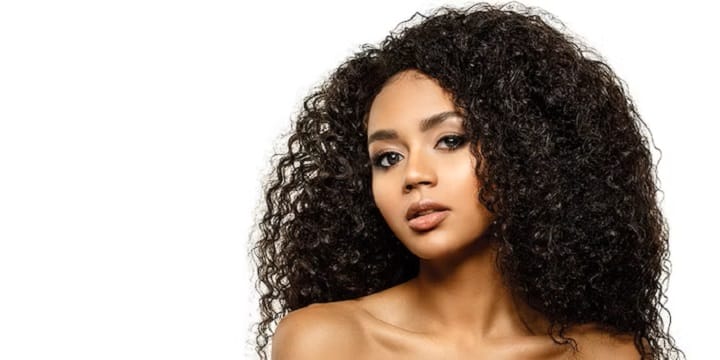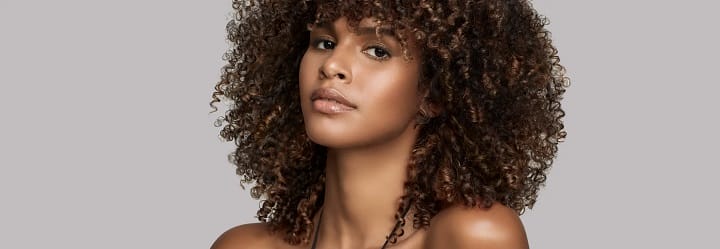Are you new to the intricacies of hairdressing? If so, then you are probably confused about hair texture. What is textured hair and what does it mean exactly? How do you treat the different hair textures?
This article might be able to answer whatever questions you have about textured hair.
Table Of Contents
What Exactly Is Textured Hair
Textured hair is an umbrella term covering different kinds and textures. Does straight hair fall under this category? Technically no, because textured hair has a very specific meaning.
Textured hair is any hair that has even a slight curl pattern. Curl patterns are most noticeable in curly or kinky hair. However, note that you can still consider it textured even if you have slightly wavy hair.
Straight hair with no texture at all does not fall under this blanket statement.
Types of Textured Hair
There are many different kinds of textured hair and it is such a broad spectrum that you cannot just categorize them into several groups.
To help you understand hair textures, here are the categories used by professional hairdressers:
Type 2
This is the “straightest” textured hair that you can get. Also called “wavy” hair. This textured hair type is further divided into three sub-categories:
Type 2A
The curls are so soft that just the weight of the strands can straighten them. This hair type is usually straight from the base down to the eye level, where the hair barely starts to curl.
Type 2B
This hair texture has a bit more volume and movement compared to 2A. The hair strands curl up from the middle of the shaft to the ends. This is the ideal hair texture for curly hairstyles with definition.
Type 2C
If you have seemingly straight hair that starts to get waves close to the crown, you are dealing with 2C textured hair. One of the characteristics of this hair texture is that it tends to get frizzy during humid days.
If you have this type of hair texture, it will look nice when styled into moisturized baddie hairstyles or hydrated butterfly locks.
Type 3
This is commonly called “curly” hair and is divided into 3 sub-categories based on their degree of curliness.
Type 3A
This curly hair type has well-defined curls. The hair naturally has s-shaped curls that form loose loops. These curls usually have a diameter that is just a bit bigger than that of a regular candle.
If you have this texture type, you should avoid over-brushing your hair as it can make it frizzy.
Type 3B
The strands of hair with Type 3B texture are slightly thinner than that of 3B, which makes the hair springier and look fuller. In terms of size, the curls are roughly the same diameter as a marker.
In addition, the curls start at the roots and go all the way to the tips. This hair texture is ideal for freeform dreads and Afro-tribal braids.
Type 3C
This has the tightest curls in the Type 3 bracket. If you have 3C hair, your curls look like tight springs. The coils are also around the same diameter as a plastic straw. This hair texture is best for styling wick dreads.
Type 4
This hair texture has the tightest s-shape among all the other types. It also comes in different subcategories, including the following:
Type 4A
This has the most visible curls in the Type 4 category. It features small hair patterns and comes with tight zigzags. The curls are tight enough that they can wrap snugly around a chopstick. The coils start right at the base of the hair and go down to the tips.
Type 4B
This hair texture has a different shape than the other types. Instead of the usual s-shape, type 4B hair has z-shaped coils. Instead of coils, type 4B hair forms zigzags, making them a bit harder to maintain.
Type 4C
This hair texture is the most coily. It is also the most delicate and fragile of this list’s hair textures. This hair type ranges in thickness from thin to coarse.
Because the zigzag coils are so tight, it makes them more prone to breaking and has less definition.
How to Determine Your Own Hair Texture
If you want to know your hair texture, you first need to wash your hair. In addition, to get a more accurate read, ensure you do not modify your hair using any hair products or styling tools.
This means no hairspray, mousse, gel or style using a curling or flat iron. Towel dry your hair after washing and just let it air dry.
Once your hair is dry, closely examine it and compare it with the earlier characteristics. You will likely find that you have a mix of different textures, but there will always be one that is most dominant: your hair texture.
Note that coloring and heat styling will significantly affect the curl pattern of your hair. When you style your hair using heat, it will not go back to your natural texture.
If true, you must wait for your hair to grow out before getting an accurate read on your natural texture.
How to Style and Maintain Textured Hair
Step 1 – Decide on a hairstyle that fits your hair texture
Once you have figured out your exact hair texture, research the best hairstyles that work on your hair. For instance, if you have Type 4A hair, you can wear any short hairstyle for black women.
Meanwhile, if you have a 4C texture, wick dreads may be more your style.
Step 2 – Have your hair styled
Depending on your hair texture, you may want to have it professionally styled. After researching and narrowing down your hairstyle options, show them to your hairdresser and ask for their advice on which one will suit you best.
Also, it is best to know if your stylist can do your desired hairstyle.
Step 3 – Maintain your hair properly
Depending on the texture of your hair, you will need to treat it differently from the rest. For instance, if you have Type 4 hair texture, know it is prone to drying and breaking, so you must condition your hair often. This will also help in preventing frizzy flyaways.
Step 4 – Use the right products for your hair
You will also need to use different products to help maintain your hair. For instance, if you have Type 3 hair, apply a good anti-frizz leave-in conditioner to prevent frizzy flyaways.
Best Products for This Type of Hair
- For Type 2 or wavy hair, your biggest concerns are adding volume and moisture to prevent frizz right from the beginning.
However, you should not use too much product as it would weigh down your hair and cause it to lose volume and bounce. - For Type 3 or curly hair, it is advisable to keep it moisturized to maintain its sleekness.
This means you need good moisturizing shampoo and conditioner, even better if the products are designed for curly hair.
The products you need to use are similar to what natural curls need. - For Type 4 or coils, do lots of moisturizing to keep your hair from breaking and frizzing.
If you have type 4 hair texture, a deep moisturizing conditioner is your best friend.
You may also need to use a hair mask at least once a week to ensure your hair is adequately moisturized.
Common Textured Hair Challenges
Textured hair does look nice, but its maintenance can be pretty overwhelming.
Here are some of the usual problems that those with textured hair have to deal with:
Breakage
Everything that you do to your hair, whether it is brushing, combing, styling and more, can do damage. So, the less you fidget with your hair, the less damage it can incur. Do not brush and style it too aggressively and too often.
Thinning
If you start noticing that your hair is no longer as thick as it used to be, it is most likely thinning. For instance, you are beginning to see more of your scalp through your parted hair than you did before.
Frizz
Although all hair textures can experience frizz, textured hair is much more prone to it, especially if the hair strands are thin. When the air gets too humid, the moisture will cause the hair strands to expand, making them revert to their natural texture.
The uneven texture is what causes your hair to frizz.
Fly-Aways
Broken hair strands cause flyaways. This means that flyaway strands result from hair breakage. This means that if you can prevent your hair from getting too fragile, you can also avoid getting flyaway strands.
This is most common in short hairstyles for black women.
Split Ends
Split ends result from too much daily wear and tear from styling and heat treatments. Unfortunately, you cannot mend split ends. The only solution is to trim them off your hair.
If you do not want to unnecessarily chop off your textured locks, avoid causing too much damage to your hair.
Dullness
Your hair becomes dull when the cuticle on top of the hair strands gets too damaged due to too much styling. The hair’s cuticle must lay flat and smooth all over the strands.
Overusing heat-styling tools and chemical damage can cause damage to the cuticle, so you probably should use those sparingly.
Tangling
Hair tangling is also the result of damage to your hair cuticle. The cuticle does not just make the hair look shiny but also makes the strands smooth. In addition, tangled hair can lead to breakage even when you brush your hair as gently as possible.
FAQ
What is a curl pattern?
Your hair’s curl pattern is the shape it looks like at rest and without applying any tension. In textured hair, the curl pattern can be a loose s-shape or a tight z-shape.
Can you have more than one curl type?
Yes, it is only natural for a person to have more than just one curl type. It is even more uncommon for someone to have just one curl pattern throughout their hair.
What is the most common problem with textured hair?
The most common problem of people who have textured hair, especially those who have tight curls, is hair tangling and breakage.
What are the most common textured hair myths?
The most common myth surrounding textured hair is that it is “bad” hair. Textured hair is versatile and unique. There are no two people who have the same hair texture. If you take care of your hair, whether textured or not, it will look amazing.
Can damaged textured hair be fixed?
It will depend on the type of damage and the extent of it. For instance, split ends can no longer be repaired. The only thing you can do with it is trim them off to prevent them from getting worse.
On the other hand, dull hair can be repaired using intensive moisturizing.
What kind of products should be used on wavy or kinky hair?
Because textured hair is prone to frizz, the essential product that people with textured hair should have in their arsenal is a good anti-frizz leave-in conditioner.
This will keep the hair moisturized so it will not be prone to damage. It will also keep the strands shiny and smooth to prevent tangling.
Anthony Giannotti is a senior writer and editor for Beardoholic and a licensed barber for more than 13 years. He owns 3 barbershops and has his own hair care product line that is sold in barbershops worldwide. Known for his impeccable technique and skills, Anthony is an expert in hair and beard care and he knows the best products and tools to get rid of all beard problems and have an amazing beard.



